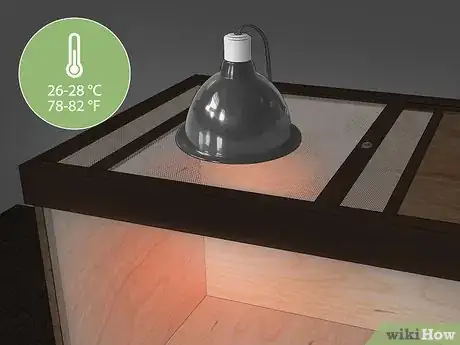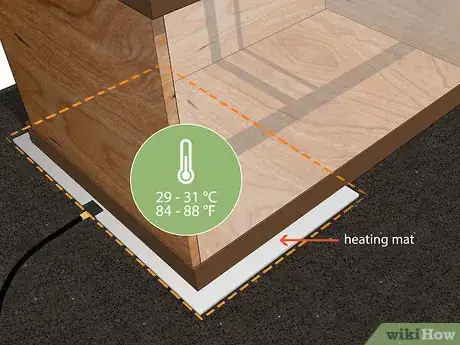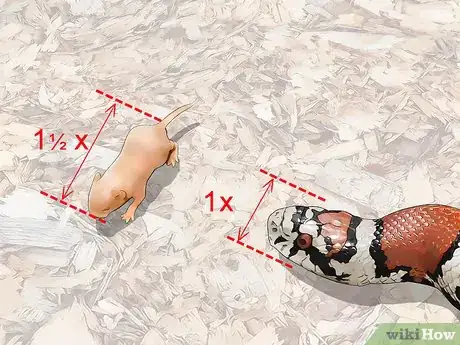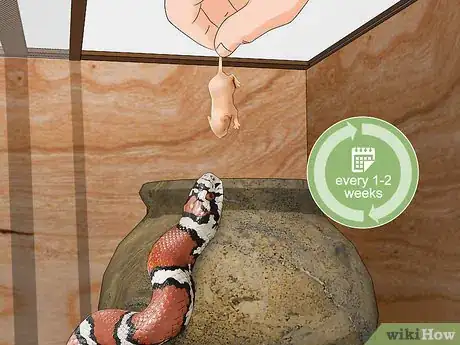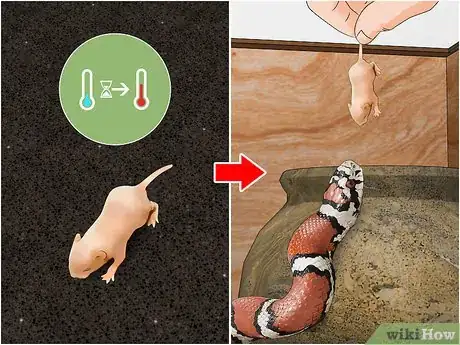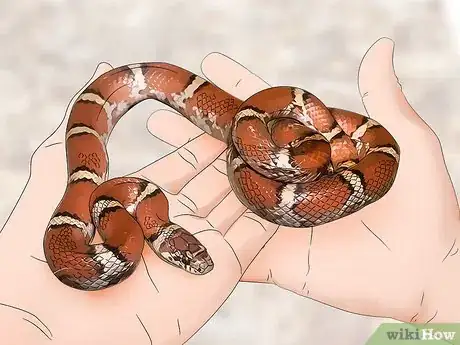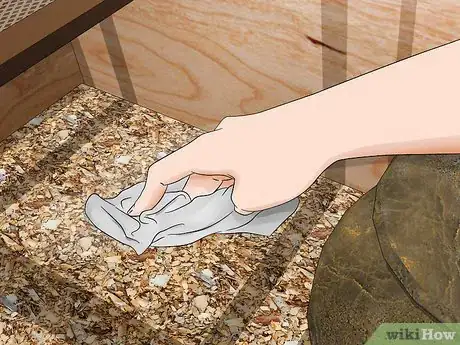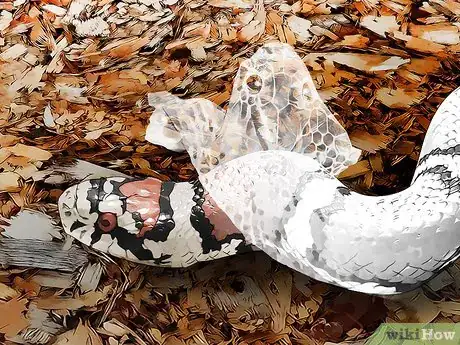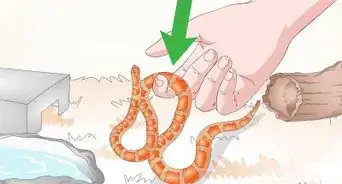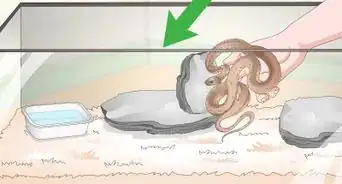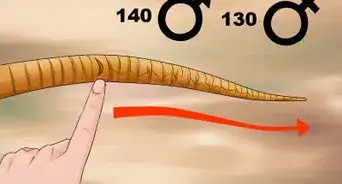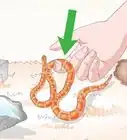This article was co-authored by Jeff Jensen. Jeff Jensen is a Reptile Specialist and the Owner of The Reptile Zone out of Bend, Oregon. With decades of experience with reptiles and wildlife, Jeff specializes in providing advice and guidance on proper reptile care. As a former science teacher and employee of the San Antonio Zoo and an accomplished herpetologist, Jeff’s dedication to knowledge and ethical pet trade practices led to The Reptile Zone being awarded a “Mark of Excellence” Award by Intrepid Marketing in 2018.
There are 8 references cited in this article, which can be found at the bottom of the page.
This article has been viewed 137,659 times.
Milk snakes are docile and make great pets, especially for first-time snake owners. While they’re lower maintenance than other pets, they still require proper care. Start by creating a habitat with the right temperature and humidity levels. Provide fresh, clean water at all times, feed your snake every 1 to 2 weeks, and keep the enclosure clean to prevent infections. By providing the right conditions, you can help ensure your pet lives a happy and healthy life!
Steps
Setting up the Enclosure
-
1Buy a tank that’s at least 24 in (61 cm) long and 16 in (41 cm) high. As a rule of thumb, the enclosure’s length should be at least two thirds the size of an adult milk snake, which is about 36 in (91 cm). A glass aquarium would work, but a reptile tank with 3 wooden sides and 1 glass side will provide the most insulation.
- If you’re raising a hatchling, house it in a 12 by 6 in (30 by 15 cm) tank until it’s a year old. A larger tank could stress out a baby snake.
-
2Use a lamp to keep the temperature between 78 and 82 °F (26 and 28 °C). To minimize brightness, choose a reptile heat lamp that emits red, black, or blue light. Keep a thermometer in the tank so you can ensure the temperature stays within the recommended range.
- Use a timer or turn off the heat lamp at night. Milk snakes are nocturnal, so keep their enclosure dark after sunset. It’s okay if the temperature drops to 65 to 70 °F (18 to 21 °C) overnight.
Advertisement -
3Install a heating pad under one side of the tank to make a hot spot. Maintain a temperature between 84 and 88 °F (29 and 31 °C) on one side of the tank. Go with a reptile terrarium heating pad or heat tape with a dimmer switch so you have more control over the temperature. Place the pad or tape under one side of the tank; it should cover about a third of the tank’s length.
- Find reptile terrarium heating pads online or at a pet store. Most have an adhesive backing and stick to the tank's underside. If your pad doesn't include them, purchase small 4 plastic feet to slightly elevate the tank. Elevating the tank prevents the pad from overheating.
- When you first install the pad, dial the dimmer to the lowest setting. Let it warm up for around 15 minutes, then take the temperature inside the tank. Increase the power gradually until the hot spot has reached the target range of 84 to 88 °F (29 to 31 °C).
- Reptiles are cold-blooded and need to move between hotter and cooler areas to control their body temperature.
-
4Maintain a humidity level between 40% and 60%. Track humidity levels using a hygrometer, or humidity monitor. To prevent skin and shedding issues, make sure the humidity stays between 40% and 60%.[1]
Tips for controlling humidity: If the tank is too dry, place a bowl of water on the side with the heating pad. If it’s too humid, use a screened or vented lid instead of a solid one, and consider investing in a dehumidifier for the room where you keep the tank.[2]
-
5Line the tank with 2 to 3 in (5.1 to 7.6 cm) of paper or wood shavings. If you want the most affordable option, go with newspaper, butcher paper, or paper towel shavings. While they’re more expensive, natural products, such as pine, cypress, or aspen shavings, are preferred over paper.
- You can find bedding labeled for reptiles online or at a pet store.
- Steer clear of cedar, which is toxic to reptiles. Additionally, avoid using sand or gravel, which could irritate your snake’s skin.
-
6Place 2 to 3 hiding spots in the tank. Purchase plastic or stone caves or make hiding spots by cutting holes in boxes and lining them with sphagnum moss. Place a hiding spot on each side of the tank so your snake can hide in both the hot and cooler temperature zones.
- Milk snakes are secretive and need hiding spots to feel secure. The hiding spots should be just large for your snake to fit inside.
Providing Food and Water
-
1Keep a heavy dish of clean water in the tank at all times. Use a sturdy bowl that won’t get knocked over. Change the water and clean the bowl with soap and hot water at least once a day. If your snake goes to the bathroom in the water, change it as soon as possible.[3]
- Unless the humidity levels are too low, keep the water on the cool side of the tank.
-
2Offer thawed feeder mice that are about as wide as your snake. As a rule of thumb, feed your snake mice that are no larger than 1 ½ times the widest point of its body. Choose frozen feeder mice instead of live prey, which could injure your snake. Thaw a feeder mouse completely before giving it to your snake, and wash your hands thoroughly after feeding your pet.
- A pinkie feeder mouse is the right size for a hatchling milk snake. As it gets older, switch to juvenile mice, then feed your fully grown milk snake adult mice.
Thawing feeder mice safely: Place a frozen mouse in a sealed plastic bag, then set the bag in container of hot water for 15 to 30 minutes. Never thaw a feeder mouse in the microwave and don’t let mice touch any containers or surfaces used to serve or prepare food.[4]
-
3Feed your snake every 1 to 2 weeks. If your snake is under a year old, feed it every 5 to 6 days. Once it’s an adult, feed it every 10 to 14 days. To feed your snake, place a wide food dish in the tank, grasp a thawed mouse with a pair of tongs, and set the mouse on the dish.
- If you breed your snake, feed it twice a week to ensure healthy egg production.
-
4Try covering the tank or warming the food if your snake won’t eat. Since milk snakes are nocturnal, feeding it at night and covering the cage could encourage it to eat. Thawing the feeder mouse for an additional 30 minutes, or until it’s warmer than room temperature, could also do the trick. If you suspect your snake is bored with its food, try switching to feeder chicks.[5]
- You could also try wiggling the mouse or chick with a pair of tongs to get your snake’s attention. Use a long pair of tongs and keep your hands as far away from the mouse as possible to avoid getting accidentally bit.
- Stressed snakes don't eat, so make sure the temperature, humidity, and other conditions in the tank are within recommended ranges. If everything checks out and your snake still won’t eat, schedule an appointment with an exotic animal vet.
Keeping Your Pet Healthy
-
1Find a local exotic animal vet with experience treating snakes. Search online for “exotic animal vet” and your location. It’s wise to find an experienced exotic vet before you bring home your snake. That way, you can schedule an appointment as quickly as possible if it gets sick.[6]
- While many snake owners don’t bring their pets to the vet regularly, check-ups every 6 to 12 months are recommended for reptiles. At a minimum, you should get your snake an initial check-up soon after you bring it home.
-
2Check your snake for signs of illness every day. Make sure your snake appears alert and flicks its tongue in and out regularly. Check for any marks or discharges on its skin, eyes, and mouth, and try to listen to its breathing to make sure it’s not wheezing.
Handling your snake: To check your snake thoroughly, gently scoop it up and use both hands to support its entire body. Grabbing the snake quickly could startle it. Handle your snake for no longer than 10 to 15 minutes; too much time out of its enclosure could lower its body temperature.
-
3Spot clean the enclosure daily. Each day, change and wash the water bowl and remove any droppings or soiled bedding. Try to clean up soiled spots promptly, as leaving droppings in the tank increases the risk of your snake getting sick.
- Be sure to wash your hands with soap and hot water for at least 20 seconds after handling your snake or cleaning its enclosure.[7]
-
4Disinfect the tank once a month. Keep your snake in a second back-up tank while you clean the main enclosure. Throw out all of the old bedding; never reuse it. Then wash the tank and hiding spots with a reptile-safe disinfectant. Rinse away the disinfectant with hot water, then add fresh bedding and put the enclosure back together.
- You can find reptile-safe disinfectants online and at pet stores. Avoid washing the enclosure in the kitchen sink or near any areas where you prepare food.
-
5Keep track of your snake’s shedding. When your snake sheds, its old skin should come off in one long, tube-shaped piece. Make sure that the eye caps have shed; take your pet to the vet if they haven’t so they can be properly removed. To promote healthy shedding, keep coarse branches in the tank and make sure the humidity stays between 40% and 60%.[8]
- Shedding is an important indicator of your pet’s health. Young milk snakes can shed 12 or more times a year, and adults typically shed every 2 to 3 months.
- The shedding process takes 1 to 2 weeks. Take your snake to the vet if it has difficulty shedding or hasn’t finished shedding within 2 weeks.
- Keeping the necessary humidity level is the first step in caring for a shedding snake. If the environment is set properly, shedding should not be a problem.
Community Q&A
-
QuestionWhat do small milk snakes eat?
 Community AnswerSmall, newborn baby mice called pinkies. You can buy frozen baby mice at a pet shop or a reptile store. They come in multiple sizes.
Community AnswerSmall, newborn baby mice called pinkies. You can buy frozen baby mice at a pet shop or a reptile store. They come in multiple sizes. -
QuestionHow do I get my baby Eastern milk snake to eat?
 Community AnswerPut him in a small container and get the smallest pinky (newborn mouse) and get tweezers to feed it with then wave it in front of the snake and it should eat it.
Community AnswerPut him in a small container and get the smallest pinky (newborn mouse) and get tweezers to feed it with then wave it in front of the snake and it should eat it. -
QuestionCan a milk snake climb up the glass in a terrarium?
 Community AnswerYes! Snakes can climb up the glass but only to the height that they are long. They use their muscles to tense and hold the position up the tank.
Community AnswerYes! Snakes can climb up the glass but only to the height that they are long. They use their muscles to tense and hold the position up the tank.
Warnings
- Like other reptiles, milk snakes can spread salmonella and other germs. Always wash your hands after handling your pet, changing its water, feeding it, and cleaning its tank.[9]⧼thumbs_response⧽
- Though milk snakes are docile by nature, handling can be stressful and should be kept to a minimum. Additionally, avoid handling your snake while it’s shedding or within 2 days of feeding it.⧼thumbs_response⧽
References
- ↑ https://www.rspca.org.uk/adviceandwelfare/pets/other/cornsnake
- ↑ http://www.reptileknowledge.com/news/controlling-humidity-in-a-snake-cage/
- ↑ https://vcahospitals.com/know-your-pet/snakes-feeding
- ↑ https://www.cdc.gov/healthypets/pets/reptiles/feeder-rodents.html
- ↑ http://www.uvma.org/snakes/top-snake-articles/what-if-my-snake-wont-eat.htm
- ↑ https://vcahospitals.com/know-your-pet/veterinary-care-annual-reptile-visit
- ↑ https://www.cdc.gov/healthypets/pets/reptiles/safe-handling.html
- ↑ https://vcahospitals.com/know-your-pet/snakes-problems
- ↑ https://www.cdc.gov/healthypets/pets/reptiles/safe-handling.html
About This Article
To care for a milk snake, house it in a tank that’s at least 24 inches long and 16 inches high to give it plenty of room to move around. Place a heavy dish of clean water in the tank and be sure to change the water daily. Feed the snake a feeder mouse every 1 to 2 weeks and, for the snake's safety, give it thawed mice instead of live prey. It's also important to spot clean the tank daily and fully disinfect the habitat once per month to maintain a healthy environment. For tips on thawing out feeder mice properly, read on!

